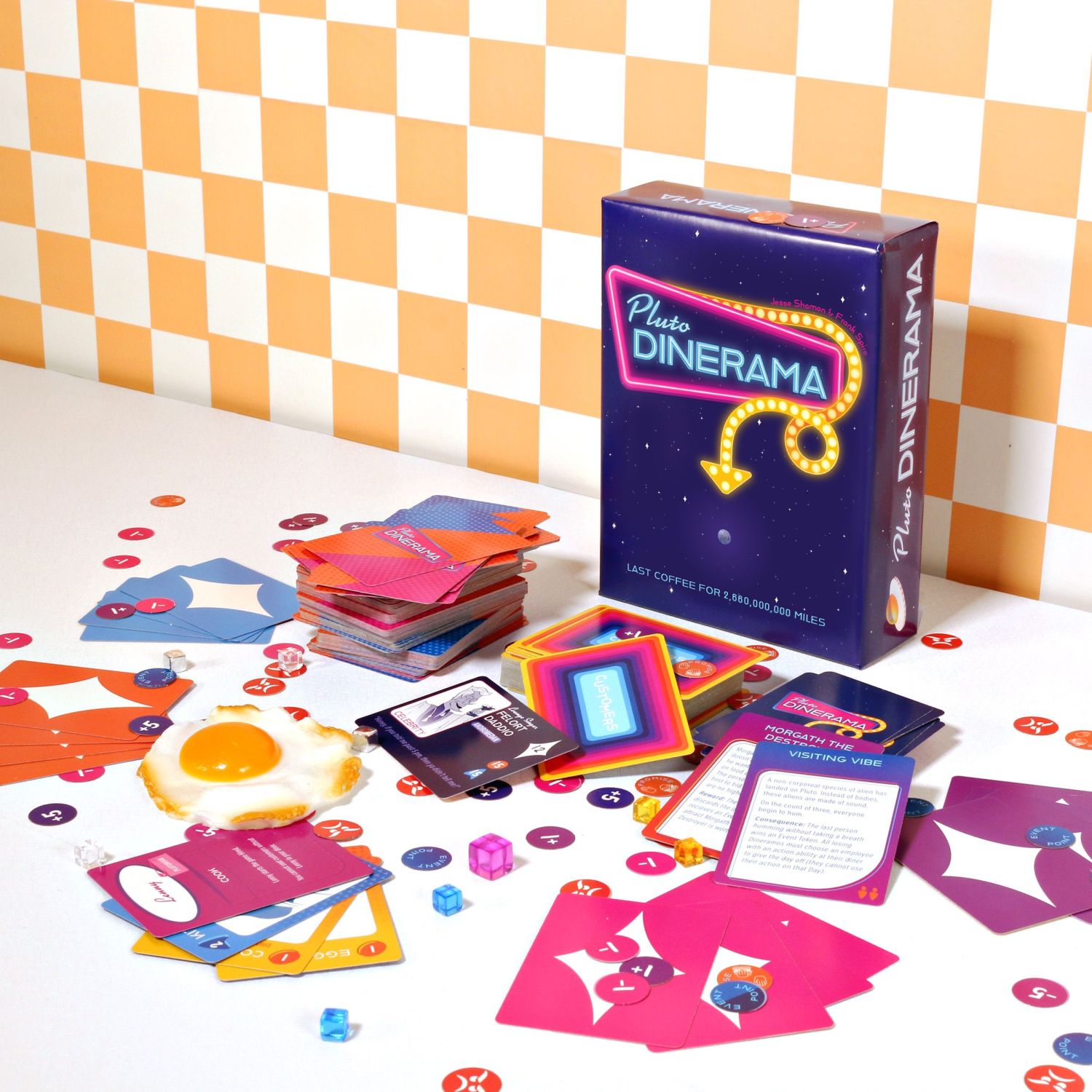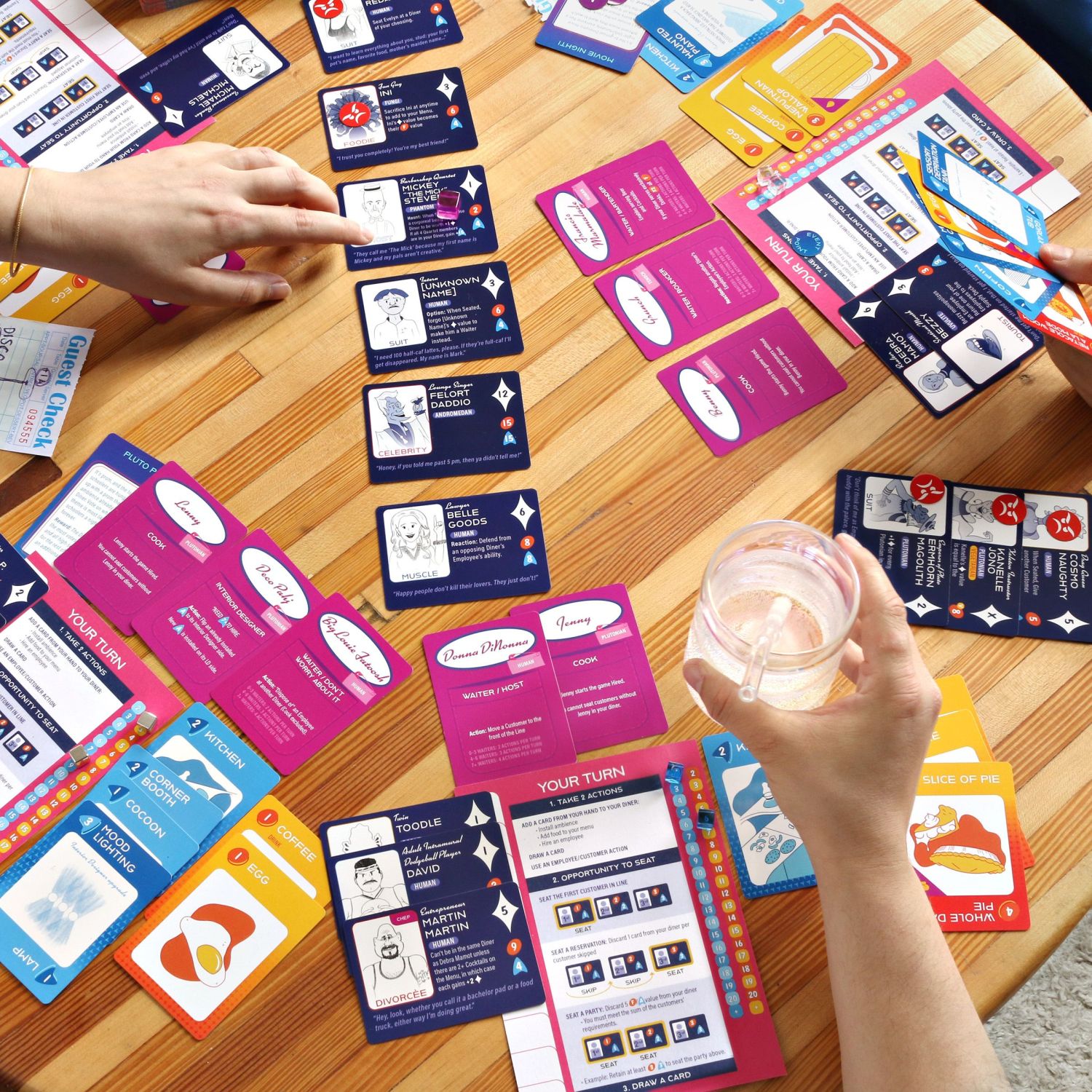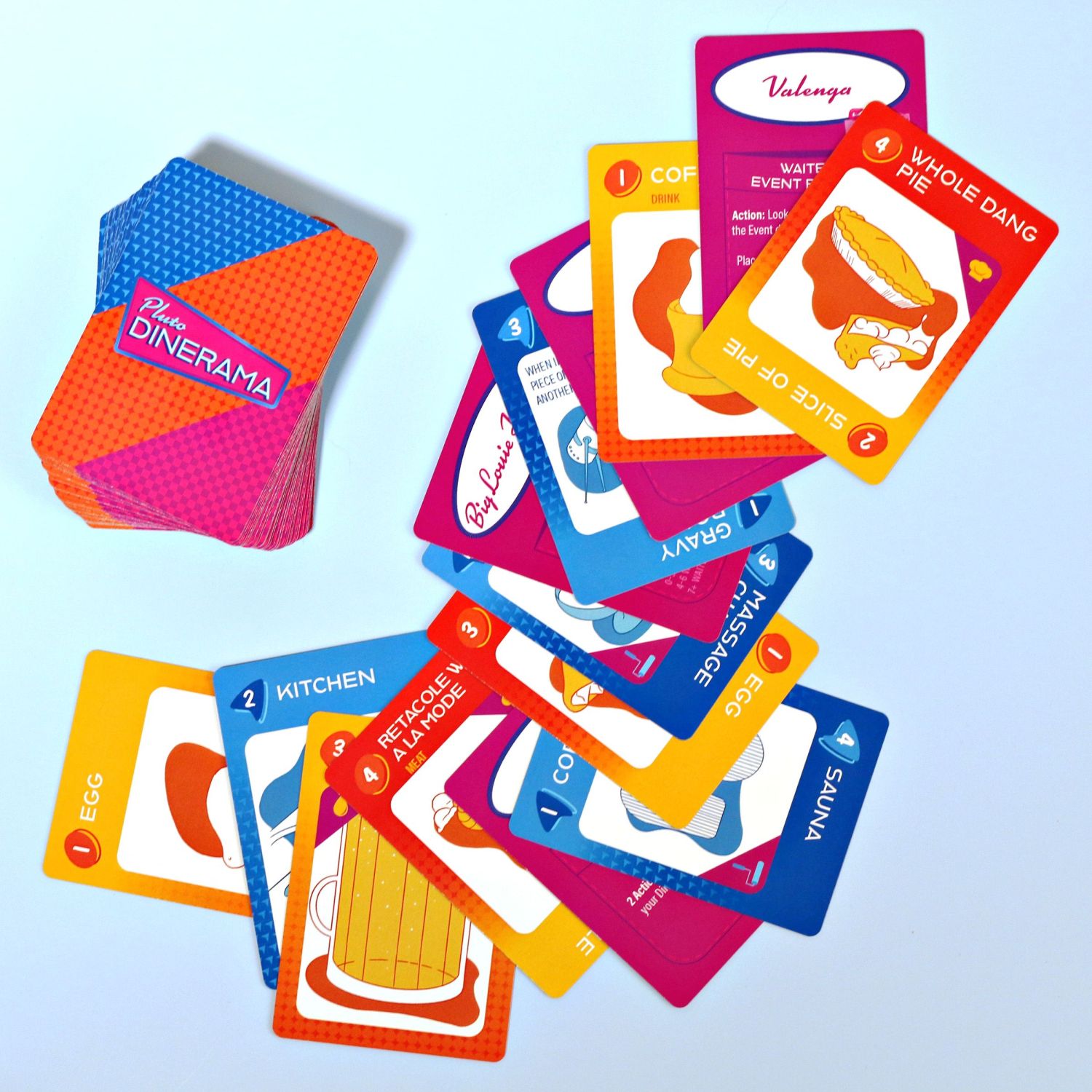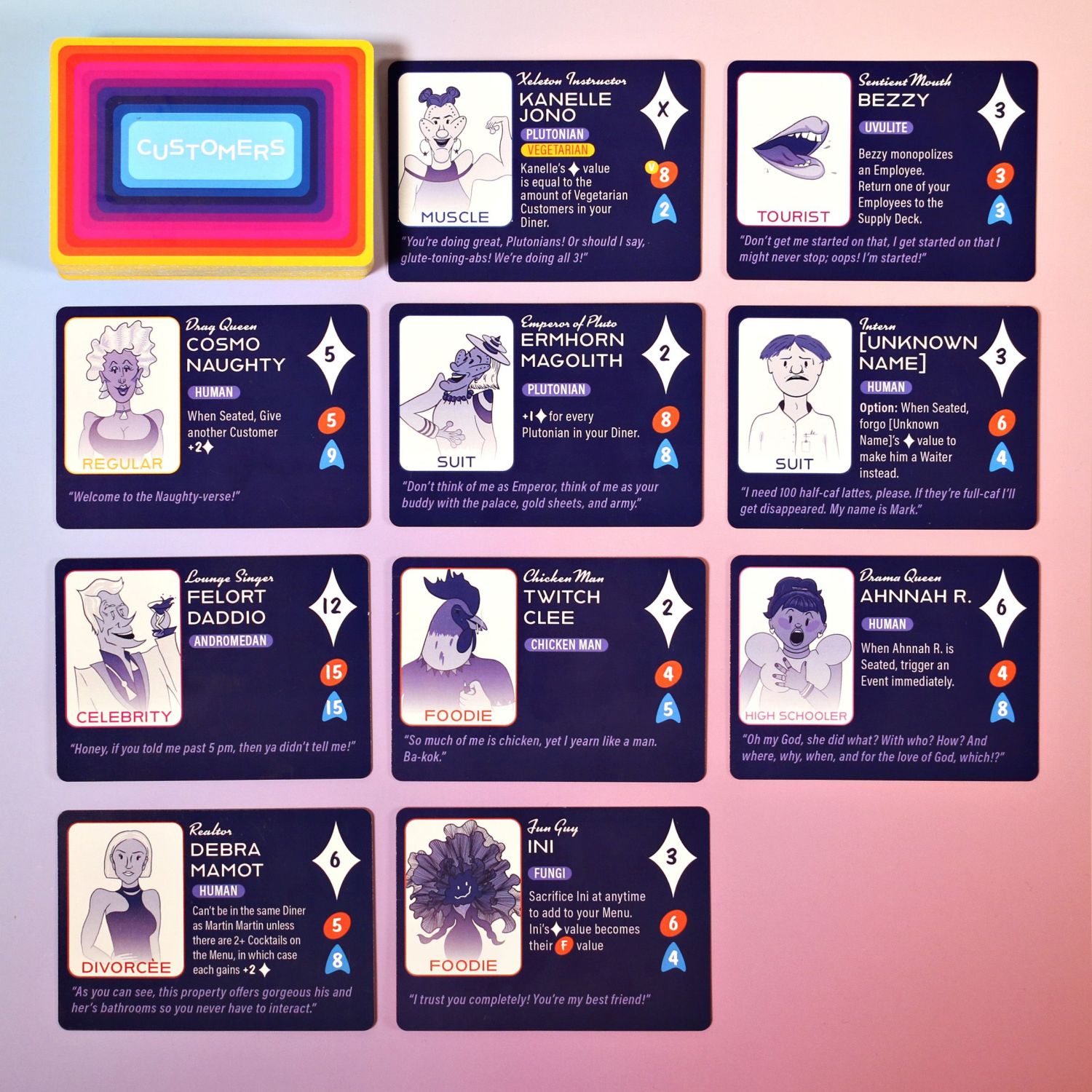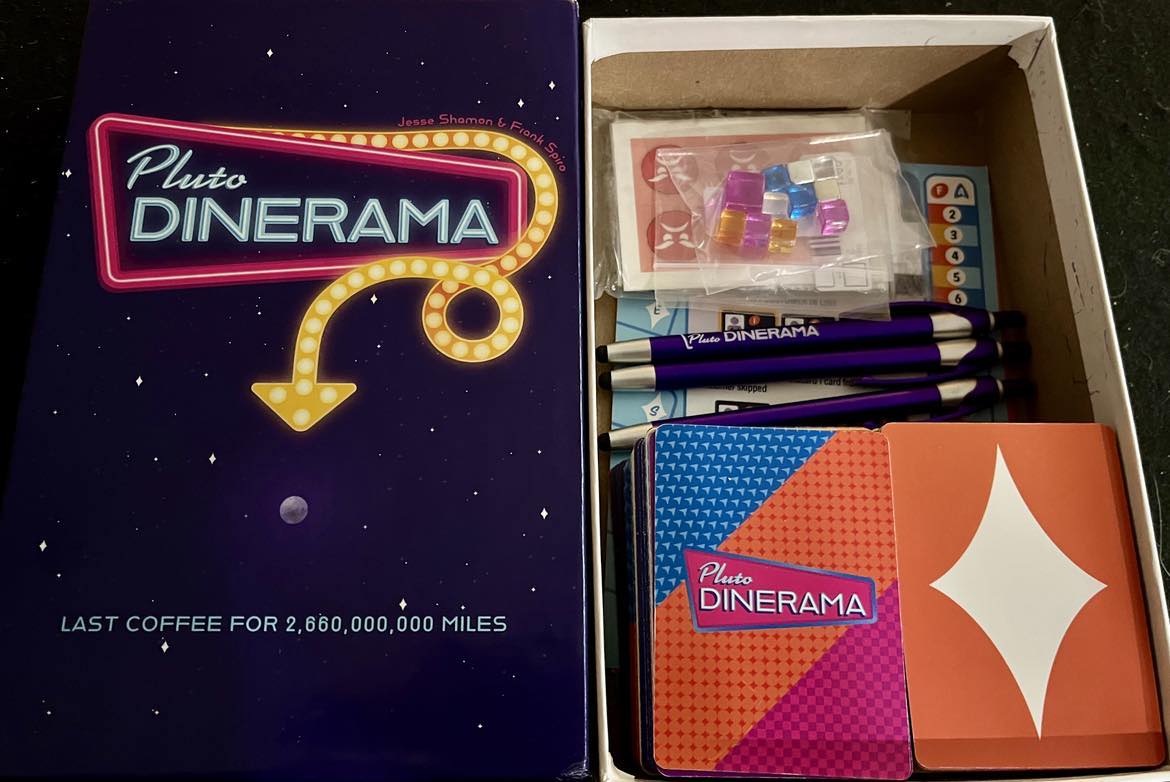So what if Pluto isn’t labeled as a planet anymore? That doesn’t mean we can’t eventually plop diners onto it and serve all sorts of rowdy customers coming and going through the solar system. Realistically, such a entrepreneurial endeavor is a ways off but that’s okay…board games exist for a reason! In “Pluto Dinerama”, an upcoming crowdfunding project, players will be working both cooperatively and competitively to serve customers and earn victory points. The copy I received was a prototype, so everything you see and read about here is subject to change. I’m also required by FTC regulations to disclose that I was paid to cover this game, however any and all opinions remain my own. The only thing paid for here was my time and expertise.
2-5 Players, Ages 10+, Average Play Time = 60-90 Minutes
—
Components & Setup
My prototype copy came with 5 placemats, 8 cube trackers, 1 front of line cube, 5 sets of starter cards 136 supply cards, 45 point tokens, 15 event point tokens, 20 hangry tokens, 34 event cards, and 53 customer cards.
To set up the game, start by giving each player a placemat and starter cards of one color, all face-up on the table. The starter cards will have values in the upper right and each player will track their F (Food) and A (Ambience) values on their mat’s tracker by adding the sum of each type. Each player then deals themselves a hand of 5 cards from the supply deck (this remains hidden from other players. Lastly, 3 cards are dealt from the supply deck face-up next to it to form the daily specials.
—
Gameplay Overview
The game is played over rounds referred to as days. A round / day consists of the morning phase, afternoon phase, and evening phase. Rounds continue until one diner has seated 10 customers (this includes the AI diner that will be playing as well) and at that point, the diner with the most stars (victory points) wins!
Morning Phase
The customer deck is shuffled and a line of customers is drawn face-up onto the table, the number of which depends on player count. The last customer drawn is first in line and you’ll place the front of line cube there as a reminder.
—
—
Afternoon Phase
The players take turns with taking actions, seating customers, and drawing a card. The player who was last in a diner, or space, goes first.
—
Actions
The active player can take two actions. These include playing a card from their hand, using an employee action, and drawing a card from either the deck or daily specials. Immediately refill the daily specials array back up to three should a player take one.
Some yellow food cards have two halves and you’ll play the half you want right-side up. The better half usually has a chef requirement, meaning you’ll need a chef in your array in order to play that half right-side up. If you don’t have a chef but acquire one later, you can spend an employee / chef action to rotate the card to the better side.
Some blue ambience cards have the same mechanic. You’ll need an interior designer to play the better half of these dual faced cards. Again, you can acquire an interior decorator later and use its employee action to rotate an already played card.
Whether you play a yellow food or a blue ambience card, players will track their food/ambience values on their personal mats.
As already alluded to above, players can also play pink employee cards to their array. Some have a when hired effect that is observed immediately.
—
Seating
After taking two actions, the active player can either seat a single customer, seat a party, or seat a reservation.
Customers have a food and ambience value with possible special conditions to be met before they can be seated. A player can seat a customer if their diner has the required food and ambience values. If a player can’t seat the current customer in line, they can discard one food or ambience card in their array to seat someone further back in line. Discarding two cards means a player can seat someone two spots back, and so on. If the active player can’t seat the customer, they get a hangry token and the front of line token moves down one for the next player’s turn.
Seating a party is a little different. The active player can discard a value of 4 food / ambience to seat any customer in line in addition to the first in line, though they have to meet the sum of both customers’ food / ambience scores. Parties can be as large as players want so as long as they spend the 4 f/a and meet the summed requirements.
The first in line cube will eventually wrap around to the original first person in line. If a “hangry” customer is skipped, they leave to go eat at the AI Rival Diner. This AI Rival Diner doesn’t play or activate abilities but can still win / end the game.
—
Draw a Card
Once the seating phase is over, the active player draws a card from the deck or daily specials. Remember to immediately replace a card in the daily specials row as needed.
—
Once all of the customers are seated, the Afternoon Phase is over.
—
—
Evening Phase
During this phase, players participate in events. Events are mini-competitions that can either be strategic (orange cards), game (pink), or creative (blue). If players agree, they can remove a particular card color from their game to focus on one or two categories that they like.
—
As explained above, rounds / days continue until any diner has seated ten customers. Players earn 2 points for every event won, 10 points for the highest food total, 10 points for the highest ambience total, 5 points for the most events won, and various points found on customers that have been seated. The player with the most points wins!
The above doesn’t go over every rule found in the rulebook, but should give you an idea as to how the game is played.
—
—
Impressions
“Pluto Dinerama” oozes theme. I envisioned a 50’s/60’s space diner as soon as I opened the box and it felt great. The cards were somewhat easy to read and the colors popped nicely. My eyesight is poor so I wish the fine-print text on the cards were slightly bigger, but that’s typically a me-problem. I loved some of the sci-fi references…Jan Vick, who looks suspiciously a lot like “John Wick” for example, can dispose of another player’s customer when seated.
I tend to favor games that are highly customizable and I’m pleased to say that this game has that and then some. Players can be as competitive or as cooperative as they want and they can even trade with each other to help keep the AI Rival Diner from winning. While not in the rulebook, you could just omit the AI Rival Diner altogether and discard hangry customers into oblivion…OR set the AI Rival Diner game end requirement to say, 15 to give players more wiggle room.
I’m a fan of engine builders, so I enjoyed building my food menu and ambience scores over time. Building up a collection of useful employees was cool too, though you can only have 15 f/a/e cards in your diner at a time (you can freely discard unwanted cards as you acquire better ones). I also rather fancied the set collecting aspect. Some customers have tags and some have variable victory point scores. One customer might give you extra points for having plutonian tags while another rewards you for having customers with vegetarian tags.
I was initially worried by the time limit aspect…that is, trying to outpace the AI Rival Diner. As I mentioned above, there are unofficial ways around that, but typically players get at least 4 actions per round. In a two player game, with five customers forming the line, the first player will get 6 actions and the second player 4 before the first in line cube wraps back around to address the hangry customers. If any are still there, players get even more actions. Taking cards doesn’t cost anything, though some have a requirement before they can be taken. The AI Rival Diner will dominate at first but players typically catch up as their engine grows.
The event cards were an interesting way to add chaos to the game, though I love that you can eliminate categories altogether. Some creative events, for example, involve voting which isn’t really fun in a two player game. Aidalee hates bidding, so we skip some of those cards as well until we deal one we both agree looks fun to try. However, she loves role playing and always enjoys discovering our diners’ personality as we build our tableaus.
While there are a lot of food-based tabletop games out there, “Pluto Dinerama” is one of the better ones I’ve played to date.
I mentioned above that my version of the game was subject to change. From what I was told, the final box will be slightly smaller, certain wording on specific cards will change, and color correction / inking will be refined. Custom pens and a receipt pad will be included in the final game as well.
The game is set to launch on Kickstarter on 8/20/2024. You can learn more about it via the crowdfunding / official site link below:
https://get.plutodinerama.com/
—

